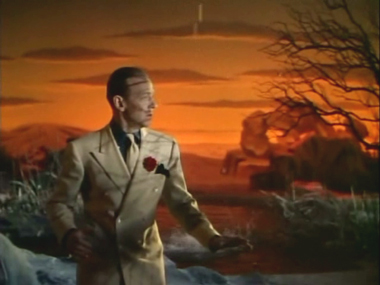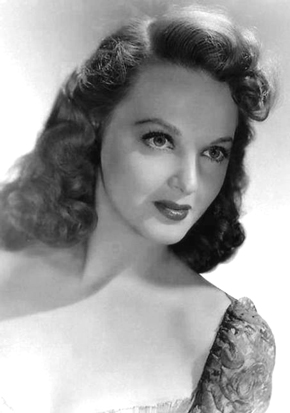
 |
|
|
|
An odd MGM musical to be sure, 1945's Yolanda and the Thief isn't so much a misfire as a picture with gears that don't quite mesh. The Arthur Freed production has its devout fans and the casual viewer will find plenty to like in it -- since when is Fred Astaire ever actually bad? But it falls into the category of shows where one isn't smiling like one should be when the lights go up. Ornate and visually "busy" to the point of distraction, the movie looks like an outgrowth of director Vincente Minnelli's grand work in the same year's Ziegfeld Follies. The talented actress and dancer Lucille Bremer got good notices for musical numbers with Fred Astaire in Follies, and Yolanda is her big buildup to stardom. 
"Doesn't mesh" is the best descriptor I can come up with for a film that never quite finds its personality. The fantasy setting is a South American country called Patria, where Technicolor has run riot. Beautiful Yolanda Aquavita (Lucille Bremer) graduates from parochial school and returns to the capitol, where we learn that she will take charge of her family's fortune. The Aquavitas apparently own everything of value and every industry in Patria. On the train are American conmen Johnny Riggs and Victor Trout (Fred Astaire & Frank Morgan); Riggs determines to bilk the innocent Yolanda out of her entire fortune. This he does by pretending to be her guardian angel: he catches Yolanda praying to a statue in her garden. Yolanda is so naíve and her Aunt Amarilla (Mildred Natwick) so dotty, that Johnny has little trouble making his score. The problem is of course that he feels guilty and falls in love. Meanwhile, Yolanda knows that she can't marry an Angel, but neither does she want Johnny to leave. We spend a lot of Yolanda and the Thief trying to figure out what kind of place Patria is. Co-author Ludwig Bemelmans made his fortune with his Madeleine books, and sure enough, Yolanda begins in a Catholic school surrounded by little girls in uniform dresses identical to those of the French storybook schoolgirl. Only these uniforms are bright red, as the art direction of Yolanda and the Thief has expanded to fill the many gaps in the thin screenplay. In fact, director Minnelli gives the film the full art direction bulldozer. As if inspired by Ms. Bremer's bright red hair, the colors in this movie run riot. By the time the third-act comes along, we've been so bombarded by Technicolor that a full-blown Carnaval sequence doesn't seem all that special... we've already overdosed on color. The fantasy setting is never quite established. Little Mexican boys (by their costumes) listen to Ludwig Stossel tell a story in the opening scene, but nobody in Patria looks particularly Latin except Yolanda's dueña in her black lace. Every once in a while somebody is addressed as Señora. Those schoolgirls look French, and the cops look Italian or Spanish. A train crossing the Patrian plains could be American. 1 People have to change money, but when Johnny uses a pay phone, it takes American nickels. With shampoo-perfect llamas appearing in several scenes Patria might be an exaggerated vision of Bolivia. It's really a faux-Ruritanian nowhere. I doubt that South Americans would be offended, even with the vision of everything of value in the country owned and operated by one family (that much is fairly accurate). But nobody will recognize themselves in this story. The 'peasants' welcome the new Aquaviva heir Yolanda back home in a spontaneous celebration, as if she were Cinderella. The presence of Frank Morgan naturally makes us think of The Wizard of Oz. Yolanda's groups of color-coded servants and citizens also remind us of life in the Emerald City. There's even a Yellow Brick Road, in Johnny's guilty dream. 
The story gives Aunt Amarilla a few good comedy lines but otherwise lacks for humor. What really stalls the show is a script that doesn't engage with its own storybook ideas. For her big break, Ms. Bremer must play a clueless goody-goody who never gets wise. Yolanda is devout, innocent and gullible enough to be taken in by a fake guardian angel, and she doesn't do much to earn our respect. The character is also fairly inconsistent. The convent girl immediately jumps into an oo-la-la Technicolor bubble bath, and then dons a sheer gown that looks more like lingerie. Yolanda is neither here nor there, but wherever the art directors want her to be. No wonder Judy Garland chose The Harvey Girls over this story. What Bremer does excel at is dancing. She's easily one of Fred Astaire's more elegant partners, and is very graceful in fluid ballet-like displays. The first big musical number is a ballet set in a strange limbo where Johnny Riggs sees gold fall from the sky but is sidetracked from his greed by a beautiful girl. Bremer is so arresting in this dance that she succeeds in pulling our attention from the wildly stylized Technicolor sets, which appear designed to resemble Salvador Dalí artwork. 2 Bremer makes a striking visual presence. She could have made Yolanda a much stronger character, if the script weren't so limiting. Fred Astaire plays his character properly, but the conman Johnny Diggs isn't a good fit for the beloved actor's screen personality. Diggs spends the majority of the film unhappy and pensive, which is definitely not Astaire's style. The one musical number that really comes to life sees Johnny and Yolanda dancing at Carnaval. "Coffee Time" is the oft-excerpted number performed on a floor decorated with squiggly zebra stripes; Yolanda and Johnny are clearly having a great time. The dancing is spirited but the real difference is that Astaire/Johnny is enjoying himself. When Astaire is having fun on screen, we can't help but have fun too. Leon Ames gets in there too, to fill out the story's guardian angel concept. Oddly, his character gives off mixed signals -- a couple of his gestures and gags suggest that he's demonic in origin. That end of the story really doesn't pay off as it should, and neither does the film's big romance. The editing skips over what should have been big scenes -- Johnny's confession, and Johnny's proposal. The movie had only to illustrate these emotional highlights, and more likely than not all would be forgiven. As it is, Lucille Bremer's day in the sun was a short one. Her screen career would end in just three years, after roles in the lowercase films noir Ruthless and Behind Locked Doors. 
Yolanda and the Thief's songs by Harry Warren and Arthur Freed include no standout tunes and are simply not memorable. But MGM's corps of ace composers and arrangers give the tracks a high gloss and lay down some good rhythms for Fred's dancing. Eugene Loring's dances are quite good, especially the group movements in the "Coffee Time" number. The surreal touches in Johnny's nightmare ballet are quite evocative, especially when Johnny's entrapment by love is expressed by wave-like blue ribbons of cloth, broad sheets barring his way, and Yolanda's golden veils. The use of hidden air jets to direct Bremer's veils predates the clever work in "The Broadway Ballet" in Singin' in the Rain. A singer named Trudy Erwin reportedly provided Ms. Bremer's singing voice; the sync is excellent. Singled out among the tots at the parochial school is little Ghislaine Perreau, later known as Gigi Perreau. Ms. Perreau had a favored spot as a young child actor and may have been on track for grooming as new MGM talent. The dissolution of the MGM studio system a few years later probably put an end to that. 
The Warner Archive Collection DVD-R of Yolanda and the Thief is really quite beautiful. Either an earlier composite negative is in excellent condition, or Warners has been doing some work on this picture, because it looks like the result of a serious restoration. Colors are vibrant and stable; I saw none of the expected mis-registration issues. I also noticed that the transfer is formatted for widescreen -- that the picture takes the correct 1:37 shape when the 16x9 setting is used on a widescreen TV. Set the monitor to 4x3 and the picture is skinny. I no longer have a 4x3 TV to check this on -- is this an illusion? The original trailer included on the disc does Yolanda no favors by hyping it as the greatest picture ever made (really). MGM seems to have done that a lot in its advertising copy, in the same breath reminding the viewer that they are the greatest studio. I'm surprised that they were never called on it. I can only assume that Louis B. Mayer's interest in Lucille Bremer dropped to zero after this show, which is a shame... she easily had the talent and personality to join the top rank of MGM musical stars.
On a scale of Excellent, Good, Fair, and Poor,
Yolanda and the Thief rates:
Footnotes:
1. The second or third establishing shot of the train is a fall-down hoot. The very large miniature is an impressive art-directed canyon; and about a third of the way through the shot we can see a stagehand moving behind a rock on the right side of the screen. He's as big as the Amazing Colossal Man. The mistake must have gone undetected until the final printing phase!
2. Actually, the designs and sets for this sequence are very good, and capture more of the essence of Dalí than those carbon-copied visuals from the celebrated Disney short subject Destino.
Reviews on the Savant main site have additional credits information and are often updated and annotated with reader input and graphics. Also, don't forget the 2010 Savant Wish List. T'was Ever Thus.
Review Staff | About DVD Talk | Newsletter Subscribe | Join DVD Talk Forum |
| ||||||||||||||||||